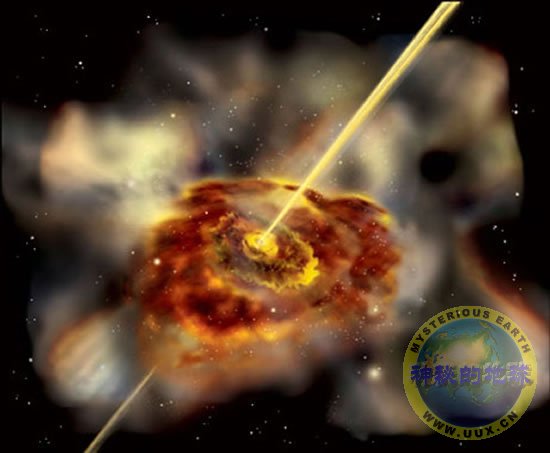Black Holes Belch Universe's Most Energetic Particles
Jets of plasma shoot out from a supermassive black hole known as an active galactic nucleus in an artist's illustration. These jets have long been suspected as the source of high-energy cosmic rays, the most energetic particles in the universe.
Now data from an observatory in Argentina suggest that active galactic nuclei are in fact the source of the highest-energy cosmic rays.
Mason Inman
for National Geographic News
November 8, 2007
The most energetic particles in the universe shoot from supermassive black holes at the centers of galaxies, a new study suggests.
Particles known as cosmic rays are constantly bombarding objects in space. The sun bathes Earth in low-energy cosmic rays, astronomers have found, and exploding stars emit medium-energy particles.
But until now researchers had not been able to pinpoint where in the sky the highest-energy cosmic rays are most likely coming from.
These particles can have energies as high as that of a baseball pitcher's fast-ball—but all that energy is packed inside a lone proton a hundred million times smaller, the study authors say.
The new research is based on data from the Pierre Auger Observatory on the plains of Argentina, which was used to search for signs of high-energy cosmic rays.
"When you look at the highest-energy cosmic rays from the most violent sources, they point back to their sources," said study co-author Paul Mantsch of Fermilab in Batavia, Illinois.
The researchers found that the high-energy rays seem to be coming from areas of the sky known to contain huge, belching black holes called active galactic nuclei.
Plasma Jets
The study is cautious about its implications, stating that the results "cannot be used alone as proof that [active galactic nuclei] are the sources."
But some members of the study team believe they now have the best possible answer.
"We discovered the sources of the highest-energy particles in the universe," said team member Miguel Mostafa of the University of Utah in Salt Lake City.
Now that we found the sources," he added, "we are one step closer to knowing what physical process can accelerate particles to these ultrahigh energies."
Active galactic nuclei are supermassive black holes at the centers of galaxies that suck in enormous amounts of matter.
(Related news: "Supermassive Black Hole at Center of Milky Way, Study Hints" [November 2, 2005].)
All matter that crosses the black hole's outer boundary, known as its event horizon, gets trapped inside by the object's intense gravity.
But active galactic nuclei have so much highly energized matter swirling into their black holes that they also send out high-speed jets of plasma.
For decades scientists had theorized that the enormous magnetic fields in these jets were flinging out high-energy cosmic rays.
The Auger observatory can't see these particles directly, but its huge array of 1,600 detectors can watch for telltale signs of their passage through Earth's atmosphere.
When the rays hit the atmosphere, they give off brief flashes of light. They also trigger sprays of hundreds of other particles that rain down on Earth in what are called "air showers."
Of the millions of cosmic rays that the observatory caught a glimpse of, it spotted only 27 with the highest energy levels.
Researchers estimate that cosmic rays that are this energetic hit a square mile (2.6 square kilometers) on Earth less than three times a century.
The researchers compared where these cosmic rays seemed to come from with the locations of more than 300 active galactic nuclei within about 325 million light-years of Earth.
"This is our local neighborhood, in cosmic terms," Mostafa said.
The team found that 20 of the 27 cosmic ray events came from very close by active galactic nuclei—something extremely unlikely to happen by chance.
The findings, which appear in this week's issue of the journal Science, are credited to the team of more than 400 scientists who designed and currently operate the Auger observatory.
Best Bet
Jonathan Arons is an astronomer with the University of California, Berkeley, who was not involved with the study.
He said that the new findings are "the first pretty convincing evidence" that the highest-energy cosmic rays come from specific sources rather than from all over the sky.
"Identifying the sources is very important, because it narrows the possibilities" of what processes are creating these cosmic rays, Arons added.
"If I had to bet … I think jets from fairly massive black holes would be my favorite bet," he said.
Michael Cherry of Louisiana State University in Baton Rouge was also not part of the study team.
He cautioned that "the statistics aren't terribly good" in the study, because the Auger team spotted only 27 instances of the highest-energy cosmic rays.
"They need a couple more years [of data collecting] to see if it stands up," he said.
But the case they've made so far, he added, "looks pretty darn convincing."












